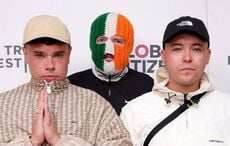IN 1830 a remarkably charismatic Irishman named James F. O'Connell was shipwrecked on the remote Pacific Island of Pohnpei. Washing ashore, he met with by a crowd of threatening locals brandishing spears.
Thinking quickly, O'Connell did what any clear thinking Irishman ought to do under such circumstances - he performed an Irish jig (the Garryowen).
The sight of this impromptu dance on the waters edge beguiled the restive natives, and soon they welcomed him into the heart of their tribe. It's a tale that might have been written by Jonathan Swift, but it actually happened. For proof, all you had to do was look at him.
O'Connell acquired a full-body tattoo in Pohnpei, where he had married and became a member of the community.
But back in New York, where he gained fame as the first man in America to display his tattoos, women and children ran screaming from him. Ministers warned from the pulpit that viewing the designs would transfer them to any woman's unborn child.
But the genie was out of the bottle, and the strange fascination of tattooing spread like wildfire from the Pacific to the U.S., and then to Europe.
In her new book Tattooing the World: Pacific Designs in Print and Skin (Columbia Press), double Fulbright scholar and professor of English at Loyola College in Maryland Juniper Ellis traces the origins and significance of modern tattoo in the works of 19th and 20th century artists, travelers, missionaries, scientists and writers, but it's O'Connell who holds her fascination and ours.
Says Ellis, "He's a lovely character. He was the first performer to present his tattoos in the U.S. professionally. From Dublin originally, he ended up shipwrecked in Pohnpei where he was met by angry warriors. But his Irish dancing completely charmed them."
After he was tattooed - and to the end of his days he claimed it was done without his knowledge or consent - he eventually married the daughter of a Pohnpei chief. Doubt is cat on O'Connell's claim to have lived on the island for five years, but it's certainly true that he remained there long enough to achieve a detailed knowledge of tattooing and of the traditions of the locals.
Making his way to New York in the mid 1830s, O'Connell became a headliner in the main circus act of the era, P.T. Barnum's American Museum. He traveled all over the eastern seaboard and further afield, showing up in New Orleans, Pittsburgh and Buffalo.
For over 20 years he lived as an itinerant performer, displaying his tattoos and the remarkable Irish dancing skills that had saved his neck in the first place.
It may be hard now in our era of tattoo parlors and radical chic to imagine what a novelty O'Connell must have been to the Americans of his era. The Tattooed Irishman, as he was known, achieved as much notoriety as fame - because religious ministers had warned from the pulpit that viewing him would transfer the patterns on his skin to a woman's unborn child, in a terrifying form of immaculate reproduction.
O'Connell's 20 year run as a performer is evidence that he became an emblematic figure. A book and many pamphlets outlining his experiences have survived, and the details he drew of island life have been confirmed by anthropologists.
In her scholarly and beautifully written book, Ellis outlines how O'Connell captures and represents the contradictory aspects of tattoos themselves. Existing at the crossroads of the private and the public, the sacred and profane, the social and the intensely personal, tattoos spark speculation, and so O'Connell became a seminal figure in brining tattoos to the U.S.
In the Pacific, Ellis argues, a tattoo was and is a visible social marker of a journey that someone has undergone. You become fully adult, a full participant in the community. They're a sign you have a mature sexuality and your marks have become indicators of strength, beauty and pride. O'Connell and his experiences capture all of that, and he gently reminds us that the Pacific is where tattoos originate. Although there was a tradition of tattooing in pre-Christian Europe (with fearsome groups like the Picts of Scotland) it was suppressed by the early church, only to thrive an ocean away.
After his death in the 1850s a hornpipe was danced on O'Connell's grave. He remained a showman to the end of his days.
Today there is a bar on Pohnpei that bears the name the Tattooed Irishman, and a drink is also named in his honor.




Comments